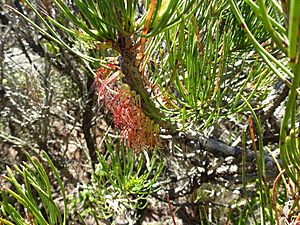Calothamnus montanus facts for kids
Quick facts for kids Calothamnus montanus |
|
|---|---|
 |
|
| Calothamnus montanus growing on Mount Trio | |
| Scientific classification | |
| Genus: |
Calothamnus
|
| Species: |
montanus
|
| Synonyms | |
|
Melaleuca georgi Craven & R.D.Edwards |
|
Calothamnus montanus is a special plant that belongs to the myrtle family, called Myrtaceae. You can only find it growing naturally in the southwest part of Western Australia. It's a straight-growing bush with short, thin leaves that look like needles. Its flowers are red and have four groups of stamens (the parts that make pollen). In 2014, some scientists suggested renaming this plant Melaleuca georgi.
About This Plant
Calothamnus montanus is a shrub that can grow up to about 2 metres (7 ft) tall. When it's young, its stems are a bit hairy. But as the plant gets older, the stems become smooth and thicker.
Its leaves are shaped like needles. They are usually about 3.5–11 millimetres (0.1–0.4 in) long and 0.8–1.0 millimetre (0.03–0.04 in) wide. If you cut a leaf in half, it would look round.
The flowers of Calothamnus montanus have four sepals and four petals. The stamens, which are the parts that hold pollen, are partly red and partly green. They are grouped into four claw-like bundles, each about 25–28 millimetres (0.98–1.1 in) long. The petals are quite small, around 2.5–3 millimetres (0.098–0.12 in) long.
This plant usually flowers from October to January. After the flowers, it grows fruits. These fruits are woody, flat, and round capsules. They are about 3–5 millimetres (0.1–0.2 in) long and are partly hidden inside the stem.
Naming the Plant
The scientific name Calothamnus montanus was first officially described in 2010. This was done by a scientist named Alex George. He found a sample of the plant in the Stirling Range National Park.
The second part of its name, montanus, comes from a Latin word. It means "montane" or "from the mountains." This name was chosen because the plant grows in mountain areas.
Where It Grows
You can find Calothamnus montanus in the Stirling Range National Park. This park is located in a natural area called the Esperance Plains biogeographic region. The plant prefers to grow in soil that comes from metamorphic rocks.
Looking After It
The Western Australian Government's Department of Parks and Wildlife has looked at Calothamnus montanus. They have decided that it is "not threatened." This means there are enough of these plants, and they are not currently at risk of disappearing.
Images for kids




